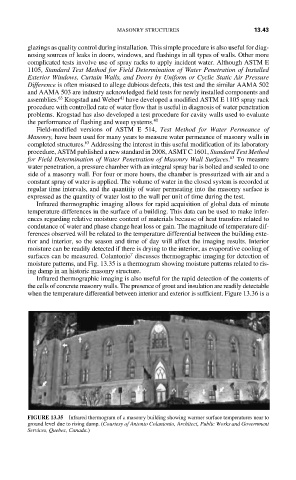Page 498 - Forensic Structural Engineering Handbook
P. 498
MASONRY STRUCTURES 13.43
glazings as quality control during installation. This simple procedure is also useful for diag-
nosing sources of leaks in doors, windows, and flashings in all types of walls. Other more
complicated tests involve use of spray racks to apply incident water. Although ASTM E
1105, Standard Test Method for Field Determination of Water Penetration of Installed
Exterior Windows, Curtain Walls, and Doors by Uniform or Cyclic Static Air Pressure
Difference is often misused to allege dubious defects, this test and the similar AAMA 502
and AAMA 503 are industry acknowledged field tests for newly installed components and
63
41
assemblies. Krogstad and Weber have developed a modified ASTM E 1105 spray rack
procedure with controlled rate of water flow that is useful in diagnosis of water penetration
problems. Krogstad has also developed a test procedure for cavity walls used to evaluate
the performance of flashing and weep systems. 40
Field-modified versions of ASTM E 514, Test Method for Water Permeance of
Masonry, have been used for many years to measure water permeance of masonry walls in
63
completed structures. Addressing the interest in this useful modification of its laboratory
procedure, ASTM published a new standard in 2008, ASMT C 1601, Standard Test Method
for Field Determination of Water Penetration of Masonry Wall Surfaces. 63 To measure
water penetration, a pressure chamber with an integral spray bar is bolted and sealed to one
side of a masonry wall. For four or more hours, the chamber is pressurized with air and a
constant spray of water is applied. The volume of water in the closed system is recorded at
regular time intervals, and the quantitiy of water permeating into the masonry surface is
expressed as the quantity of water lost to the wall per unit of time during the test.
Infrared thermographic imaging allows for rapid acquisition of global data of minute
temperature differences in the surface of a building. This data can be used to make infer-
ences regarding relative moisture content of materials because of heat transfers related to
condutance of water and phase change heat loss or gain. The magnitude of temperature dif-
ferences observed will be related to the temperature differential between the building exte-
rior and interior, so the season and time of day will affect the imaging results. Interior
moisture can be readily detected if there is drying to the interior, as evaporative cooling of
7
surfaces can be measured. Colantonio discusses thermographic imaging for detection of
moisture patterns, and Fig. 13.35 is a thermogram showing moisture patterns related to ris-
ing damp in an historic masonry structure.
Infrared thermographic imaging is also useful for the rapid detection of the contents of
the cells of concrete masonry walls. The presence of grout and insulation are readily detectable
when the temperature differential between interior and exterior is sufficient. Figure 13.36 is a
FIGURE 13.35 Infrared thermogram of a masonry building showing warmer surface temperatures near to
ground level due to rising damp. (Courtesy of Antonio Colantonio, Architect, Public Works and Government
Services, Quebec, Canada.)

